Ancient soap fragrance secrets include sacred herb infusion techniques pioneered by Phoenicians using olive oil and ash lye, Egyptian botanical blending methods that layer complementary scents, herbal essence distillation capturing volatile compounds, perfuming rituals combining myrrh and frankincense for longevity, and strategic carrier oil selection for ideal scent release. You'll discover how these time-tested methods can transform your modern soap-making practice with therapeutic benefits that extend beyond mere cleansing.
Sacred Herb Infusion Methods From Mesopotamian Soap Crafters
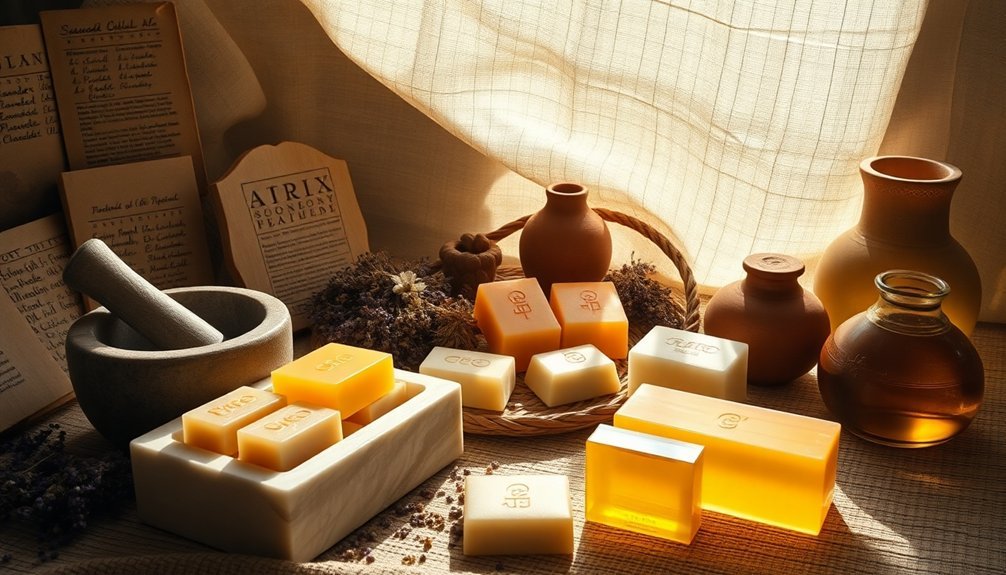
While modern soap makers rely on precise measurements and commercial ingredients, ancient Mesopotamian crafters developed sophisticated herb infusion techniques that remain relevant today.
These artisans mastered the art of blending olive oil with ash lye as their foundation, then enriched their formulations with local flora.
You'll find their saponification process, pioneered by Phoenicians around 600 B.C., extracted the full therapeutic potential from sacred plants like myrrh, frankincense, and cedarwood.
Their ritualistic approach wasn't merely for fragrance—specific herb combinations carried spiritual significance while promoting wellness.
What makes their methods exceptional is their commitment to natural ingredients.
Forgotten Botanical Blending Techniques of Egyptian Soap Makers
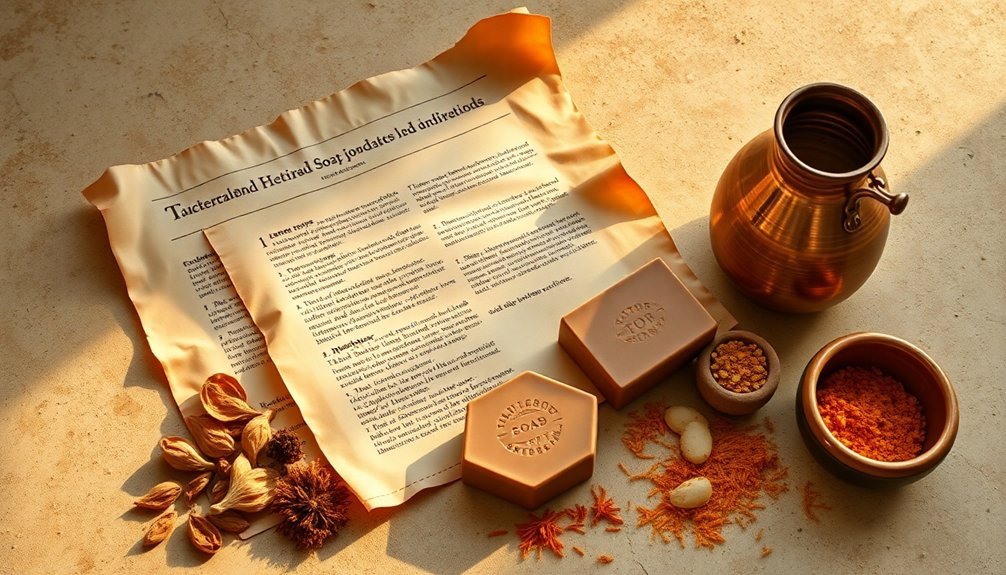
As Mesopotamian soap traditions traveled south along ancient trade routes, Egyptian artisans developed their own distinctive botanical blending techniques. They mastered the art of combining olive oil with alkaline ash while infusing their creations with complex fragrances.
You'll find their botanical blending approach particularly fascinating—they didn't just add scents, they orchestrated them. Egyptian soap makers layered complementary fragrances to create products that pleased both the senses and nourished the skin.
| Egyptian Ingredient | Benefit to Skin | Fragrance Note | Modern Equivalent |
|---|---|---|---|
| Olive Oil | Deep moisturizing | Subtle, earthy | Extra virgin olive oil |
| Myrrh | Healing, anti-aging | Warm, balsamic | Essential oil |
| Frankincense | Rejuvenating | Spicy, woody | Resin extract |
| Sesame Oil | Protective | Nutty, warm | Cold-pressed oil |
Historical Distillation Secrets for Capturing Herbal Essences
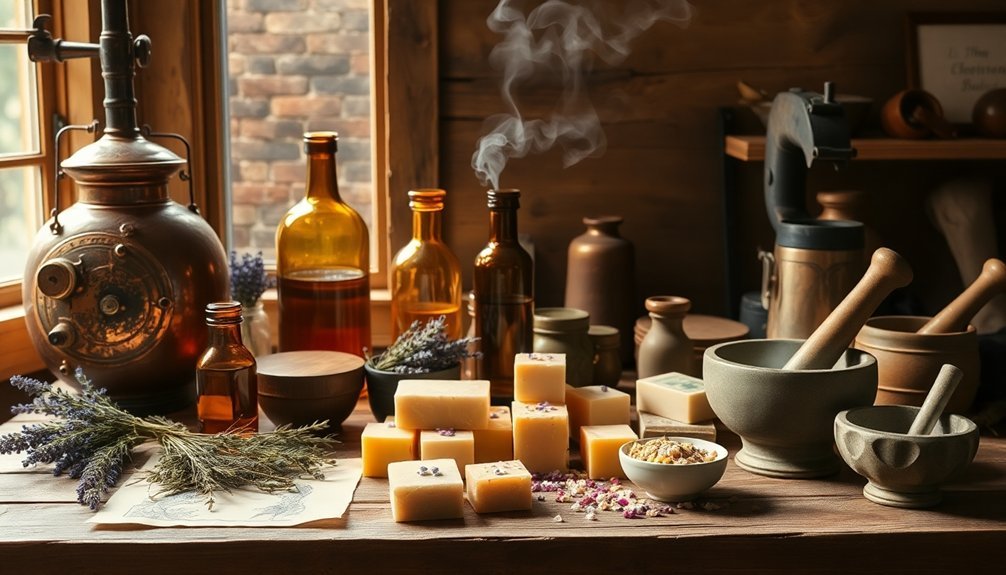
Long before modern laboratories existed, ancient civilizations mastered the delicate art of herbal essence extraction through remarkably sophisticated distillation methods. The Egyptians pioneered these techniques over 4,000 years ago, using steam and water distillation to capture volatile compounds from aromatic plants.
You'll find it fascinating that Phoenicians applied these herbal essences in their soap-making around 600 B.C., having discovered the saponification process that transformed these fragrances into cleansing products.
Their understanding of distillation techniques preserved both the natural scents and therapeutic properties of plants like lavender and rosemary.
The skin benefits of these extracted essences weren't merely coincidental. Ancient soap makers recognized that certain herbal components offered cleansing and healing properties—knowledge that forms the foundation of today's natural soap crafting practices.
Ancient Perfuming Rituals That Enhanced Soap Fragrance Longevity
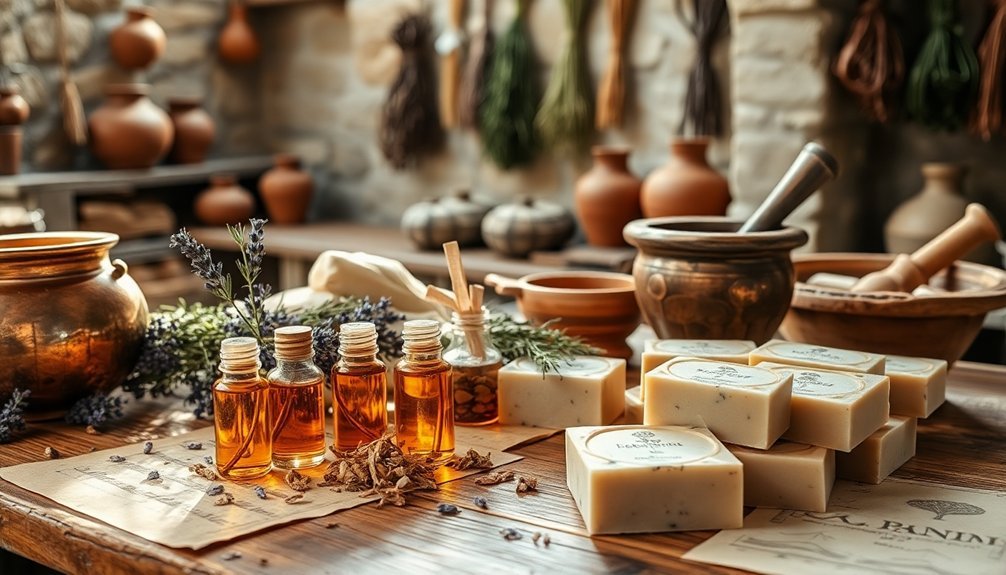
Beyond the extraction of herbal essences, ancient civilizations developed sophisticated perfuming rituals that greatly extended soap fragrance longevity. The Egyptians' technique of blending myrrh and frankincense into soaps remains one of the best methods for enhancing natural scents without artificial fragrances.
You'll find Phoenician wisdom particularly valuable—they discovered that aromatic plant extracts not only improved fragrance but also introduced anti-inflammatory properties to their natural soaps.
Romans elevated this science by incorporating flower and spice oils into tallow-based formulations, creating luxurious bathing experiences.
The ancient practice of layering specific herb combinations, like lavender with cedarwood, amplified both scent and therapeutic benefits. This intentional infusion of resins and tinctures during saponification preserved aromatic qualities while establishing fragrance foundations that modern soap makers still emulate today.
Traditional Carrier Oil Selection for Optimal Herbal Scent Release
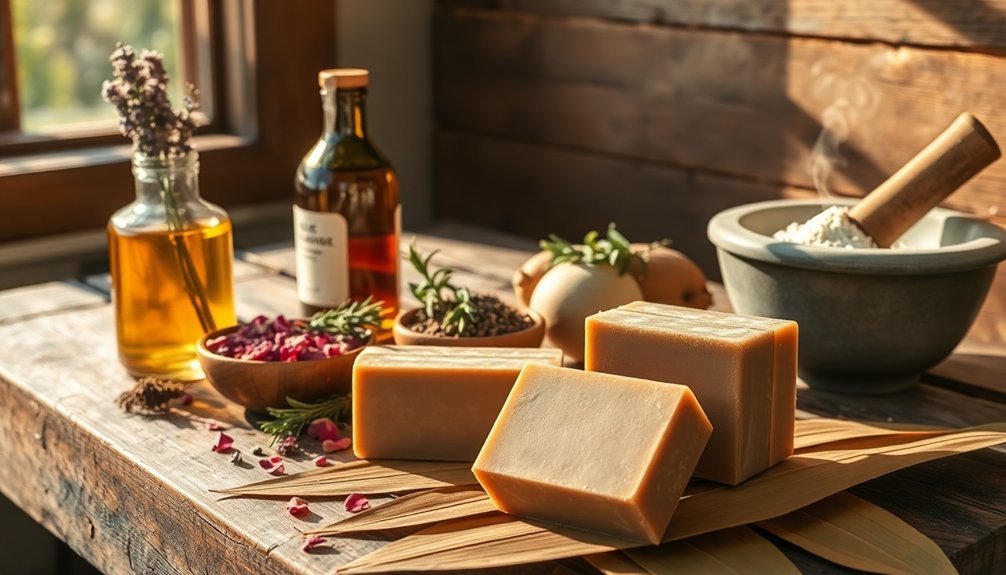
While ancient herbalists crafted exquisite fragrances, they recognized that carrier oils formed the foundation of every aromatic soap creation.
You'll find their wisdom still applies when selecting the perfect base for your herbal soap.
- Choose olive or coconut oils for their exceptional ability to absorb and release essential oils.
- Select jojoba oil with its low comedogenic rating to enhance fragrance without clogging pores.
- Incorporate sweet almond oil, rich in fatty acids, to preserve your essential oils' potency.
- Blend multiple carrier oils to create complex, well-rounded scent profiles.
- Add avocado oil for dual benefits—superior scent release and nourishing skin properties.
The careful selection of carrier oils doesn't just determine how your herbal soap smells—it transforms the aromatic experience while delivering therapeutic skin benefits ancient soap makers valued.
Frequently Asked Questions
What Is the Best Fragrance for Soap Making?
You'll find lavender, citrus scents, and herbal fragrances like rosemary and mint are top choices for soap making. Consider blending oils to create complex aromas while ensuring they're compatible with other ingredients.
How to Anchor Fragrance in CP Soap?
To anchor fragrance in CP soap, add high-quality oils at trace, blend complementary scents, use fixatives like clay or orris root, and cure your soap for 4-6 weeks. You'll enjoy longer-lasting scents this way.
How to Make Soap Smell Stronger?
You'll achieve stronger soap scents by using 3-5% essential oils, adding fragrance at trace stage, incorporating soap-specific fragrance oils, and including natural additives like dried herbs. Store finished bars in cool, dark places.
How Does Herbal Soap Work?
Herbal soap works through saponification, combining oils with alkaline solution to cleanse. You'll benefit from plant extracts that provide hydration, antibacterial properties, and maintain your skin's natural pH while avoiding harsh chemicals.
In Summary
You've now uncovered the ancient wisdom that transforms ordinary soap into aromatic treasures. By adopting these five historical techniques—Mesopotamian herb infusions, Egyptian botanical blending, traditional distillation methods, ancient perfuming rituals, and strategic carrier oil selection—you'll create fragrances that rival those enjoyed by royalty centuries ago. Don't let these precious secrets remain buried in history. Your hands can craft what time nearly forgot.





Leave a Reply